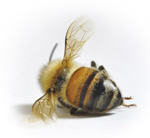17
May
A Decade into the Pollinator Crisis, Unsustainable Bee Losses Continue
(Beyond Pesticides, May 17, 2016) It was 10 years ago that commercial beekeepers first reported widespread, unsustainable winter losses of their honey bee colonies. A decade after the alarm was first sounded on pollinator declines, results of 2015-16 Colony Loss Survey show no sign the crisis of abating. According to the Bee Informed Partnership survey, beekeepers lost 28.1% of their colonies over this past winter, and a total of 44% of their colonies over the last year.
 This marks the second year in a row that summer declines (28.1%) were on par with declines experienced during winter. Beekeepers factor in that a small percentage, <15% of their colonies, will be lost each winter, but do not expect to lose colonies during the summer, when there is amble forage and nectar for bees. The costs beekeepers must incur to keep their hives alive continue to increase. More time and money is spent to maintain their hives, yet losses continue to be staggering ”” and unsustainable.
This marks the second year in a row that summer declines (28.1%) were on par with declines experienced during winter. Beekeepers factor in that a small percentage, <15% of their colonies, will be lost each winter, but do not expect to lose colonies during the summer, when there is amble forage and nectar for bees. The costs beekeepers must incur to keep their hives alive continue to increase. More time and money is spent to maintain their hives, yet losses continue to be staggering ”” and unsustainable.
As colony collapse disorder (CCD), the cryptic loss of honey bee colonies with no sign of dead bees in or around the hive, has faded from public discussion, concerns over pollinator declines in general, from bees to butterflies and other wild and native species, have risen. CCD is not altogether eliminated or solved, but there is growing recognition that pollinator declines are not confined to honey bees. Just think: if honey bees are dying off at unprecedented rates, even with support from beekeepers, what might the losses be to bumble bees and other native pollinators? Preliminary research finds that they are at considerable risk.
The growing scientific consensus is that a class of systemic, persistent insecticides called neonicotinoids are most significant contributing factor to outsized declines in wild pollinators and managed honey bee colonies. Although the manufacturers of these chemicals, multinational companies Bayer and Syngenta continue to misrepresent the crisis by indicating that bee colony health is fine or improving, or that parasitic mites, after all, are the real issue, U.S. residents, consumers, and policymakers are beginning to see through the corporate fog.
While it is likely that neonicotinoids are not the sole factor in pollinator declines, they have been found to exacerbate other challenges that pollinators face. These chemicals weaken the immune system of honey bees, making them more likely to succumb to disease carried by varroa mites and other parasites. Multiple studies have found that bees exposed to neonicotinoids have more parasite and pathogen problems. If this disturbing trend of pollinator losses is to be broken, bees must must be better protected from neonics. Beyond Pesticides believes that exposure to harmful pesticides is something within our control, and it’s also something policy makers can ”” and must ”” do something about quickly.
In the states of Maryland and Connecticut, lawmakers are taking action to restrict the use of these harmful pesticides. Numerous local communities, universities, and retailers have also taken steps to remove neonicotinoid pesticides from use. At the federal level, Congress has an opportunity to suspend the use of neonics until they have been proven not to result in unreasonable adverse effects on pollinators through the Saving America’s Pollinators Act. While the White House has established a National Pollinator Health Strategy, it is evident that more will need to be done to address pesticide use in order to achieve President Obama’s goal of no more than 15% annual winter losses within the next decade. In a recent report, the Government Accountability Office concurred that the U.S. Environmental Protection Agency and Department of Agriculture are not doing enough to protect pollinators.
Though folks that follow this issue closely have heard it before, it’s worth repeating: honey bees and other pollinators are responsible for one in three bites of food on American’s dinner plates. And it’s not the bread, oats, or eggs that need pollinators, but the nutritious, healthy fruits and vegetables that depend on bees, butterflies, beetles, birds, bats and other pollinators. Beyond the utilitarian view of these important species, it is critical to protect these pollinators for the inherent value that they provide to landscapes and biodiversity. Every species lost during the ongoing pollinator crisis means a little less is known about life on this planet.
Help reverse pollinator declines by starting locally. Discontinue the use of neonic insecticides, and synthetic pesticides in general, and advocate that your neighbors and local government do the same. Use the Bee Protective Habitat Guide to plant a pollinator garden, and consider seeding white clover into your lawn. Join in and support the Keep the Hives Alive Tour this June, as it travels across the country to raise awareness about pollinator declines from hazardous pesticides, and encourage safer practices.
All unattributed positions and opinions in this piece are those of Beyond Pesticides.
Source: Bee Informed Partnership










